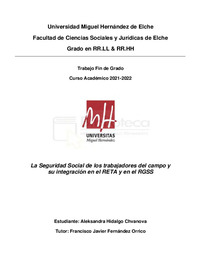Por favor, use este identificador para citar o enlazar este ítem:
https://hdl.handle.net/11000/27952Registro completo de metadatos
| Campo DC | Valor | Lengua/Idioma |
|---|---|---|
| dc.contributor.advisor | Fernández Orrico, Francisco Javier | - |
| dc.contributor.author | Hidalgo Chvanova, Aleksandra | - |
| dc.contributor.other | Departamentos de la UMH::Ciencias Sociales y Humanas | es_ES |
| dc.date.accessioned | 2022-10-19T10:57:01Z | - |
| dc.date.available | 2022-10-19T10:57:01Z | - |
| dc.date.created | 2022-06 | - |
| dc.identifier.uri | https://hdl.handle.net/11000/27952 | - |
| dc.description.abstract | El Régimen Especial Agrario nació a mediados del siglo pasado (s. XX), en el momento en el que el sector agrario ocupaba un puesto de primera línea en la actividad económica. Su objetivo fue el de incorporar a los trabajadores agrarios por cuenta propia y por cuenta ajena a la protección de la Seguridad Social para dotarles de particularidades en materia de cotización y de prestaciones. ¿Se llevó a cabo este objetivo? ¿Cómo se encontraba la población agraria a mediados de los años sesenta? ¿Qué sucesos históricos han ocurrido para que se lleve a cabo una reforma en el ámbito agrario? ¿Qué efectos ha producido? A través de esta investigación se avanzará en la historia del Régimen Especial Agrario desde mediados de los años sesenta para conocer la influencia que ha tenido la política y sociedad de la época en la evolución de los cambios del régimen. Se estudiarán los diversos acontecimientos que llevaron a la desaparición del Régimen Especial Agrario, así como a definir el término en un futuro, tal y como lo conocemos ahora: Sistema Especial Agrario. | es_ES |
| dc.description.abstract | The Special Agrarian Regime was born in the middle of the last century, at a time when the agrarian sector occupied a leading position in economic activity. Its objective was to incorporate self-employed and employed agricultural workers to the protection of Social Security, to provide them with particularities in terms of contributions and benefits. Was this objective achieved? How was the agrarian population in the mid-1960s? What historical events have occurred to carry out a reform in the agrarian field? What effects has it produced? Through this research, the history of the Special Agrarian Regime will be advanced since the mid-1960s to learn about the influence that the politics and society of the time have had on the evolution of the regime changes. The establishment of the legal systems that led to the disappearance of the Special Agrarian Regime will be studied, as well as to define the term in the future, as we know it now: Special Agrarian System. | es_ES |
| dc.format | application/pdf | es_ES |
| dc.format.extent | 85 | es_ES |
| dc.language.iso | spa | es_ES |
| dc.publisher | Universidad Miguel Hernández de Elche | es_ES |
| dc.rights | info:eu-repo/semantics/openAccess | es_ES |
| dc.rights | Attribution-NonCommercial-NoDerivatives 4.0 Internacional | * |
| dc.rights.uri | http://creativecommons.org/licenses/by-nc-nd/4.0/ | * |
| dc.subject | Seguridad Social | es_ES |
| dc.subject | trabajadores agrarios por cuenta ajena | es_ES |
| dc.subject | trabajadores agrarios por cuenta propia | es_ES |
| dc.subject | Sistema Especial | es_ES |
| dc.subject | RETA-REA-RGSS | es_ES |
| dc.subject | Social Security | es_ES |
| dc.subject | agricultural workers employed by others | es_ES |
| dc.subject | self-employed agricultural workers | es_ES |
| dc.subject | Special System | es_ES |
| dc.subject.other | CDU::3 - Ciencias sociales::33 - Economía::331 - Trabajo. Relaciones laborales. Ocupación. Organización del trabajo | es_ES |
| dc.title | La Seguridad Social de los trabajadores del campo y su integración en el RETA y en el RGSS | es_ES |
| dc.type | info:eu-repo/semantics/bachelorThesis | es_ES |

Ver/Abrir:
TFG-Hidalgo Chvanova, Aleksandra.pdf
391,58 kB
Adobe PDF
Compartir:
Ver/Abrir:
TFG-Anexos.pdf
8,21 MB
Adobe PDF
Compartir:
 La licencia se describe como: Atribución-NonComercial-NoDerivada 4.0 Internacional.
La licencia se describe como: Atribución-NonComercial-NoDerivada 4.0 Internacional.
.png)